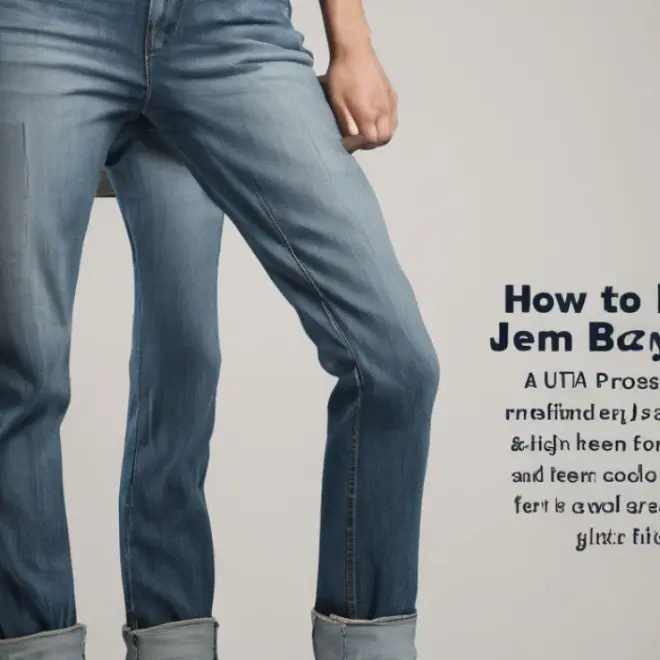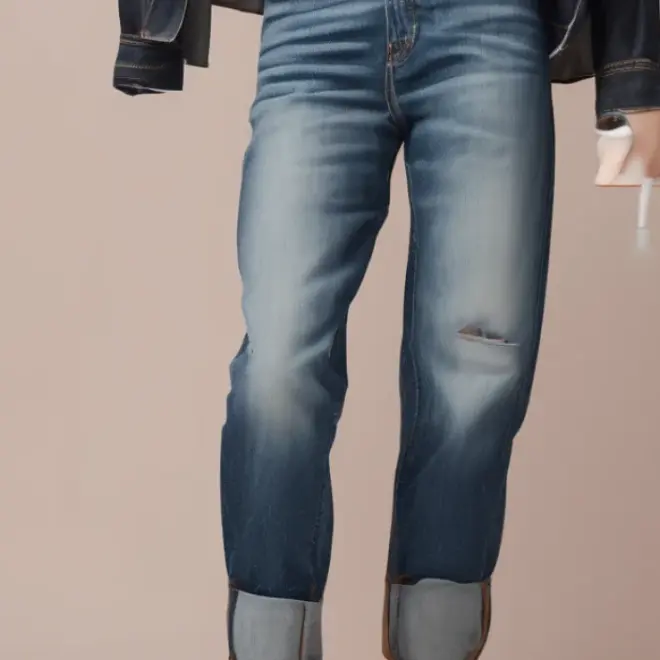To hem flare jeans and remove tough stains effectively, focus on pre-treating stains with products like OxiClean before hemming. A good hem requires accurate measurements and secure stitching, while stain removal involves identifying the stain type and using the right cleaning agent. Combining these skills ensures your favorite flare jeans look great and remain stain-free.
Flare jeans have a distinctive silhouette that can make them a favorite for many. However, life happens, and stains can appear, especially on lighter washes or when working in the garden or kitchen. Mending a hem is one thing, but tackling a stubborn stain while also ensuring your hem job is neat can feel like a double challenge. Don’t worry! With a few simple steps and the right approach, you can restore your flare jeans to their former glory, both in fit and appearance.
This guide will walk you through the process of hemming your flare jeans, incorporating proven stain removal techniques that are safe for denim. We’ll cover everything from measuring for the perfect hem length to selecting the best stain removers for common denim accidents. By the end, you’ll feel confident in your ability to tackle both form and function, making your favorite pair of jeans look as good as new.
Understanding Your Flare Jeans: Fit and Fabric
Before we dive into hemming and stain removal, let’s take a moment to appreciate what makes flare jeans unique and how their fabric composition can affect our approach. Flare jeans are characterized by their fitted thigh and knee, which gradually widen from the knee down to the ankle, creating that iconic bell-bottom shape.
Most denim is made from cotton, but it can be blended with other fibers like spandex (elastane or Lycra) to provide stretch and comfort. Understanding your jeans’ fabric content is crucial for both hemming and stain removal. Check the care label inside your jeans. A higher percentage of cotton generally means the denim is more robust but might be more prone to shrinking or wrinkling. Fabrics with spandex offer a flattering stretch but might require gentler handling during cleaning and sometimes during the hemming process if the fabric is particularly stretchy.
Step-by-Step Guide: How to Hem Flare Jeans
Achieving the perfect hem is all about precision. Too long, and you’ll be tripping; too short, and they won’t have the desired flare effect. Follow these steps carefully for a professional-looking hem.
1. Prepare Your Jeans and Select Your Footwear
Put on the shoes you typically wear with your flare jeans. This is critical because the hem length needs to be adjusted based on the shoe height. You want your jeans to hit the perfect spot – usually just grazing the top of the shoe, or slightly longer to create a slight “sweep” over the shoe. Make sure your jeans are laid out flat on a hard surface before measuring, or worn as described.
2. Determine the Desired Length
With your jeans on and wearing your chosen shoes, stand in front of a full-length mirror.
Let the jeans fall naturally.
Observe where the current hemline falls.
Decide where you want the new hem to end. For most flare jeans, you want the hem to almost touch the floor or the top of your shoe. A good rule of thumb is to aim for the hem to cover about 75-80% of your shoe’s heel.
Use a washable fabric marker or a piece of chalk to mark the desired new hem length on the outer seam of each leg. Start from the inseam side and move outwards. It’s often easier to mark the length from the inner seam (inseam) and then transfer that measurement to the outer seam later if needed; ensure it’s consistent all around.
A longer hem can sometimes look more stylish with flares, providing a fuller sweep.
3. Mark the Hemline Precisely
Once you’ve decided on the length, take off your jeans. Lay them flat on a clean, hard surface.
Measure from the crotch seam (where the two inseams meet) down to your marked point on the outer seam. This is your desired inseam length.
Lay the jeans flat and smooth out any wrinkles.
Using your fabric marker or chalk, draw a straight line across the leg at your desired hem length, ensuring it’s perpendicular to the leg’s seam.
Repeat this process for the other leg, ensuring the length is identical. Use a ruler or measuring tape to confirm both legs are precisely the same length. For consistency, it’s best to measure from the inseam on both legs.
4. Cut the Excess Fabric
This is an irreversible step, so double-check your measurements!
Measure down about 1 to 1.5 inches from your marked hemline. This extra length will be used for the new hem fold. Mark this second line.
Using sharp fabric scissors, carefully cut along the second line you marked. Cut straight across the leg.
Discard the excess fabric, or save it for another small sewing project.
Ensure the cut is clean and straight.
5. Prepare the Hem for Sewing
There are a few ways to finish the hem. For flare jeans, a simple double fold is common and durable.
Take the cut edge of the fabric on one leg and fold it upwards toward the wrong side of the jeans, aligning it with your original hemline mark. Press this fold firmly with an iron to create a crease. This creates your first fold.
Fold the fabric up once more, so the raw edge is completely enclosed within this second fold. The finished hem should be about 0.5 to 0.75 inches wide.
Press this second fold firmly with your iron. You should now have a clean, un-frayed hemline that is ready for sewing.
* Repeat for the other leg.
6. Sew the Hem
You have a few options for sewing:
Option A: By Hand (for a subtle finish)
- Thread a needle with a matching thread color (or a contrasting color if you want a visible stitch).
- Tie a knot at the end of the thread.
- Begin sewing from the inside of the hem fold, through the doubled fabric.
- Use a blind hem stitch or a small, consistent catchstitch. The goal is to catch just a few threads of the main jean fabric on each stitch, so the stitches are almost invisible from the outside.
- Continue sewing all the way around the leg.
- When you reach the beginning, tie off the thread securely to prevent unraveling.
Option B: By Sewing Machine (for a quicker, stronger hem)
- Thread your sewing machine with a needle suitable for denim and a matching thread color.
- Set your machine for a straight stitch. Many sewing machines have a specific “denim” or “jeans” stitch setting that can be helpful.
- Position the folded hem under the presser foot, ensuring the raw edge is securely tucked inside the folds.
- Align the needle with the edge of the fold.
- Sew a straight stitch all the way around the leg of the jean. Sew close to the top folded edge of the hem to secure it well.
- When you complete the circle, backstitch a few stitches to reinforce the seam and prevent it from coming undone.
- Trim any excess threads.
For flare jeans, you might need to reposition the pant leg under the machine arm as you sew to navigate the curve of the flare.
7. Final Touches
Try on your jeans to admire your work! Make sure the length is perfect and the hem looks neat. If you’re happy, give the hem a final press with your iron. If you cut off the factory hem, you might want to consider giving the new hem a slightly distressed look to match the rest of the jean by gently rubbing the seam with a piece of sandpaper or a pumice stone.
Proven Stain Removal for Denim: Tackling Common Issues
Stains on denim can be frustrating, especially when you’ve just spent time perfecting the hem. The key to successful stain removal is acting quickly and using the right agent for the type of stain. Here’s a guide to some common culprits and how to tackle them, with a special focus on using OxiClean.
General Stain Removal Principles
- Act Fast: The sooner you treat a stain, the easier it will be to remove.
- Identify the Stain: Knowing what caused the stain helps you choose the most effective treatment.
- Test First: Always test any stain remover on an inconspicuous area of your jeans (like the inside of a hem or waistband) to ensure it doesn’t damage the fabric or color.
- Blot, Don’t Rub: Rubbing can spread the stain and damage the fabric fibers. Gently blot from the outside of the stain inward.
- Rinse Thoroughly: After treatment, rinse the area completely with cool water.
- Avoid Heat: Do not put stained items in a dryer until you are sure the stain is gone. Heat can set stains permanently.
Using OxiClean for Denim Stains
OxiClean is a popular oxygen-based bleach that is generally safe for colors and most fabrics, including denim. It works by releasing oxygen when mixed with water, which helps to break down and lift stains. It’s particularly effective on organic stains like grass, food, and mud.
How to Use OxiClean for “How to Hem Flare Jeans with OxiClean” Effective Stain Removal:
Method 1: Pre-Soak for Stubborn Stains
- Mix OxiClean with water in a basin or sink. Follow the instructions on the OxiClean packaging for the correct ratio (usually about 1 scoop per gallon of water). Use warm or hot water as recommended by the product for best results on tough stains.
- Submerge the stained portion of your flare jeans (or the entire garment if heavily soiled) into the OxiClean solution.
- Let the jeans soak for at least 1-6 hours, or even overnight for very tough stains.
- After soaking, gently rub the stained area to help loosen any remaining residue.
- Wash the jeans as usual with your regular detergent. Then, air dry or check if the stain is gone before tumble drying.
Method 2: Paste for Targeted Treatment
- Mix a small amount of OxiClean powder with water to create a thick paste.
- Apply the paste directly to the stain, ensuring it is fully covered.
- Let the paste sit on the stain for about 30 minutes to an hour.
- Gently rub the treated area with a soft brush or cloth.
- Rinse the area thoroughly with cool water.
- Wash the jeans as usual.
Common Stains and Specific Treatments
While OxiClean is a great all-rounder, some stains benefit from additional steps. Here’s a look at other common stains:
| Stain Type | Initial Action | Treatment Options | Notes for Denim |
|---|---|---|---|
| Grease/Oil | Blot excess with a clean cloth or paper towel. Sprinkle cornstarch or baking soda on the stain to absorb oil. Let sit for 15-30 minutes, then brush off. | Dish soap (like Dawn) is excellent for cutting grease. Apply directly to the stain, gently rub, let sit for 5-10 minutes, then rinse. OxiClean pre-soak can also help. | Be patient. Grease can be stubborn on denim. Repeat dish soap treatment if necessary. |
| Ink (Ballpoint) | Place a paper towel under the stain. Dab with rubbing alcohol or an alcohol-based hand sanitizer. | Continue dabbing. Once the ink transfers to the paper towel, rinse with cold water. Apply OxiClean pre-soak if residue remains. | Avoid rubbing. Work from the outside of the stain. Rubbing alcohol can sometimes lighten dark denim, so test first. |
| Mud/Dirt | Let the mud dry completely. Brush off as much dry dirt as possible. | Pre-treat with a laundry pre-treater or apply OxiClean paste/pre-soak. | Mud stains are usually straightforward once dry. OxiClean is very effective here. |
| Grass | Rinse with cold water. | Use an enzyme-based stain remover or an OxiClean pre-soak. Laundry detergent can also work if applied directly. | Enzyme cleaners help break down chlorophyll. |
| Blood | Rinse immediately with cold water. Never use hot water, as it will set the stain. | Soak in cold water with OxiClean. Hydrogen peroxide can be carefully dabbed onto the stain (test for colorfastness first, it can bleach!). | The colder the water, the better. OxiClean is a safer alternative to hydrogen peroxide for general use. |
| Red Wine | Blot up excess wine. Cover with salt to absorb liquid. | Soak in OxiClean solution. For stubborn stains, a paste of baking soda and water, or a commercial red wine remover can be used. | White vinegar can also help neutralize red wine before washing. |
Hemming and Stain Removal: The Combined Approach
When you have a stain on your jeans that needs hemming, the best strategy is to tackle the stain before you permanently alter the hem. Why? Because many stain removal processes involve soaking or intense washing, which could potentially affect the stitching or fabric structure of a newly hemmed area.
- Assess: First, determine if the stain is in the area that will be cut off. If it is, great! You can snip away the stained part.
- Treat First: If the stain is in the area you want to keep, treat it thoroughly according to the steps above. OxiClean pre-soaking is often ideal because it cleans the entire garment gently.
- Wash and Dry: After stain treatment, wash your jeans as usual according to their care label. Air dry them completely to check if the stain is gone.
- Hem Next: Once you are satisfied that the stain has been removed (or where you hemmed is clear of the stain), proceed with hemming your jeans.
Important Considerations for Denim Care
Beyond hemming and stain removal, proper care will extend the life of your flare jeans:
- Washing Frequency: Wash denim less often to preserve its color and shape. Spot clean minor stains and opt for airing out jeans between wears.
- Washing Method: Turn jeans inside out before washing to protect the outer surface and preserve color. Use cool water and a gentle cycle.
- Detergent Choice: Use a mild detergent. Avoid bleach unless specifically for stain treatment and always test first.
- Drying: Air drying is best for denim. If using a dryer, use a low heat setting and remove them while slightly damp to prevent over-drying and shrinking. You can find more on best practices for washing denim from organizations like the Cotton Incorporated, a leader in cotton research.
DIY vs. Professional Hemming and Stain Removal
While this guide empowers you to handle both hemming and stain removal at home, it’s worth considering when a professional might be the better option.
When to Consider Professional Help
Hemming:
- Delicate Fabrics: If your flare jeans are made from an unusual or very delicate material that’s prone to damage.
- Complex Designs: Jeans with intricate embroidery, lace, or embellishments along the hem might be best handled by a tailor.
- Perfect Original Hem: If you want to preserve the original factory hem for a specific look, a tailor can often reattach the original hem after shortening.
- Lack of Confidence: If you’re very nervous about cutting your denim, a professional can ensure a perfect result.
Stain Removal:
- Vintage or Priceless Jeans: For cherished, expensive, or vintage denim, the risk of damage might outweigh the cost of professional cleaning.
- Unknown Stains: If you have absolutely no idea what caused the stain and it’s on a valuable pair of jeans, a professional cleaner might have specialized treatments.
- Stubborn, Set-In Stains: Some stains, especially those that have been washed and dried multiple times, may require commercial-grade solvents or techniques that are best left to professionals. Information on fabric care and stain removal can also be found via resources like the FabricLink.com, which provides textile information and care guides









